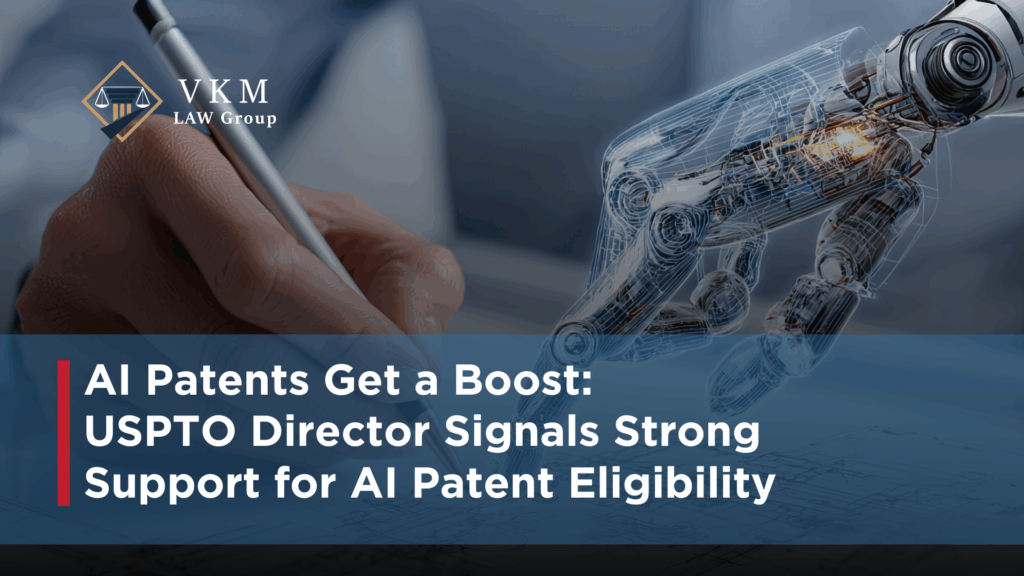
In a bold signal to innovators in artificial intelligence, the newly appointed Director of the U.S. Patent and Trademark Office (USPTO), John A. Squires, has taken swift action to support the patent eligibility of AI-based technologies. Just a week after his appointment, he led a critical Appeals Review Panel (ARP) decision that could reshape the way AI inventions are evaluated under U.S. patent law.
Director Squires Moves Fast on AI Patent Eligibility
On September 30, 2025, Director Squires, along with Acting Commissioner Valencia Martin Wallace and Vice Chief Judge Michael W. Kim, convened the rarely used ARP to issue a significant decision in Ex parte Desjardins. The panel vacated a prior rejection by the Patent Trial and Appeal Board (PTAB), declaring that the claims for a machine learning-based invention are patent-eligible under 35 U.S.C. § 101.
This move is more than a procedural correction—it’s a policy signal. Squires explicitly warned that “categorically excluding AI innovations from patent protection in the United States jeopardizes America’s leadership in this critical emerging technology.”
Background of the Invention: Smarter Machine Learning
The underlying application, U.S. Application No. 16/319,040, describes methods for training machine learning models in a way that uses less storage, simplifies system architecture, and preserves learned knowledge across multiple tasks. These improvements are particularly relevant as AI systems increasingly need to perform more tasks without retraining from scratch.
Previously, the PTAB had deemed the claims to be abstract mathematical calculations and lacking a practical application under the Alice framework. However, on rehearing, the ARP reversed course. They emphasized that the invention demonstrated technical improvements to machine learning systems—a hallmark of patent eligibility per precedents like Enfish v. Microsoft.
A Policy Shift: From §101 to §§102, 103, and 112
One of the most important takeaways from this decision is the emphasis on moving away from restrictive §101 analysis. The ARP advised patent examiners and PTAB panels to focus more on traditional statutory requirements like novelty (§102), non-obviousness (§103), and adequate disclosure (§112), rather than stretching §101 to deny protection to emerging technologies.
The Director’s opinion called out the dangers of an “overbroad” reading of the Alice test and cautioned against labeling AI innovations as mere algorithms or abstract ideas.
Alignment with Director Squires’ Broader Vision
This decision isn’t a one-off. Within his first week, Director Squires also approved patents in two other often-challenged areas: cryptocurrency and medical diagnostics. In public remarks, he has made it clear that the USPTO under his leadership will be more receptive to “applied technologies”—even those traditionally viewed as ineligible.
Squires’ message is clear: “The U.S. Patent Office is open for business, especially for the technologies of tomorrow.”
What This Means for AI and Emerging Tech Innovators
If you’re innovating in artificial intelligence, machine learning, or related fields, this decision offers new momentum for your patent strategy. Here’s what to consider going forward:
✅ Reevaluate Past Rejections
- If you previously deprioritized an AI-related application due to §101 concerns, it might be time to resurrect and reframe that filing.
✅ Strengthen Technical Disclosures
- Clearly articulate how your invention improves computer functionality or solves a technical problem.
- Include diagrams, examples, and data to show practical benefits like reduced storage or increased efficiency.
✅ Prepare for §§ 102 and 103 Scrutiny
- Expect greater focus on novelty and non-obviousness.
- Provide a compelling narrative in your specification that distinguishes your invention from prior art.
✅ Use the Decision in Advocacy
- Cite Ex parte Desjardins in interviews with Examiners or PTAB appeals.
- Emphasize that AI innovations can meet the standard of patent-eligible subject matter when properly described.
Why This Matters for IP Protection in New Jersey and Beyond
At VKM Law Group, we help innovators across New Jersey and the U.S. secure patents that protect real-world impact. The Desjardins decision opens doors for startups, researchers, and enterprises working on cutting-edge AI tools that were previously considered unpatentable.
Whether you’re developing adaptive machine learning models, generative AI systems, or intelligent diagnostics, our team is ready to navigate the shifting USPTO landscape with you.
Key Takeaways
- Director Squires is reshaping the USPTO’s approach to AI inventions.
- Patent applications in AI now have stronger eligibility prospects, especially when technical advantages are clearly described.
- Innovators should adjust their drafting and prosecution strategies to reflect the renewed focus on §§102, 103, and 112.
Need help updating or reviving your AI-related patent filings?
Contact VKM Law Group today — your New Jersey-based partner in Intellectual Property and Innovation Law.